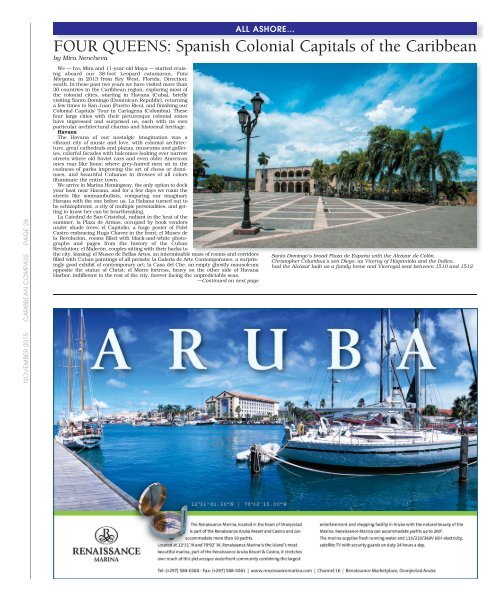Caribbean Compass Yachting Magazine November 2015
Welcome to Caribbean Compass, the most widely-read boating publication in the Caribbean! THE MOST NEWS YOU CAN USE - feature articles on cruising destinations, regattas, environment, events...
Welcome to Caribbean Compass, the most widely-read boating publication in the Caribbean! THE MOST NEWS YOU CAN USE - feature articles on cruising destinations, regattas, environment, events...
Create successful ePaper yourself
Turn your PDF publications into a flip-book with our unique Google optimized e-Paper software.
NOVEMBER <strong>2015</strong> CARIBBEAN COMPASS PAGE 26<br />
ALL ASHORE…<br />
FOUR QUEENS: Spanish Colonial Capitals of the <strong>Caribbean</strong><br />
by Mira Nencheva<br />
We — Ivo, Mira and 11-year-old Maya — started cruising<br />
aboard our 38-foot Leopard catamaran, Fata<br />
Morgana, in 2013 from Key West, Florida. Direction:<br />
south. In these past two years we have visited more than<br />
30 countries in the <strong>Caribbean</strong> region, exploring most of<br />
the colonial cities, starting in Havana (Cuba), briefly<br />
visiting Santo Domingo (Dominican Republic), returning<br />
a few times to San Juan (Puerto Rico), and finishing our<br />
Colonial Capitals’ Tour in Cartagena (Colombia). These<br />
four large cities with their picturesque colonial zones<br />
have impressed and surprised us, each with its own<br />
particular architectural charms and historical heritage.<br />
Havana<br />
The Havana of our nostalgic imagination was a<br />
vibrant city of music and love, with colonial architecture,<br />
great cathedrals and plazas, museums and galleries,<br />
colorful facades with balconies looking over narrow<br />
streets where old Soviet cars and even older American<br />
ones roar like lions; where grey-haired men sit in the<br />
coolness of parks improving the art of chess or dominoes,<br />
and beautiful Cubanas in dresses of all colors<br />
illuminate the entire town.<br />
We arrive in Marina Hemingway, the only option to dock<br />
your boat near Havana, and for a few days we roam the<br />
streets like somnambulists, comparing our imaginary<br />
Havana with the one before us. La Habana turned out to<br />
be schizophrenic, a city of multiple personalities, and getting<br />
to know her can be heartbreaking.<br />
La Catedral de San Cristobal, radiant in the heat of the<br />
summer, la Plaza de Armas, occupied by book vendors<br />
under shade trees; el Capitolio, a huge poster of Fidel<br />
Castro embracing Hugo Chavez in the front; el Museo de<br />
la Revolucion, rooms filled with black-and-white photographs<br />
and pages from the history of the Cuban<br />
Revolution; el Malecón, couples sitting with their backs to<br />
the city, kissing; el Museo de Bellas Artes, an interminable maze of rooms and corridors<br />
filled with Cuban paintings of all periods; la Galeria de Arte Contemporaneo, a surprisingly<br />
good exhibit of contemporary art; la Casa del Che, an empty ghostly mausoleum<br />
opposite the statue of Christ; el Morro fortress, heavy on the other side of Havana<br />
Harbor, indifferent to the rest of the city, forever facing the unpredictable seas.<br />
—Continued on next page<br />
Santo Domingo’s broad Plaza de España with the Alcázar de Colón.<br />
Christopher Columbus’s son Diego, as Viceroy of Hispaniola and the Indies,<br />
had the Alcázar built as a family home and Viceregal seat between 1510 and 1512


















